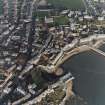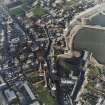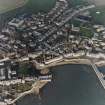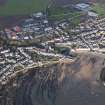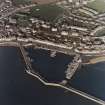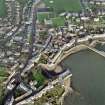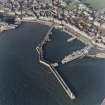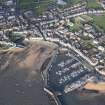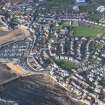Anstruther Easter, School Green, St Adrian's Parish Church
Church (17th Century), Commemorative Monument (17th Century), Bell (17th Century)
Site Name Anstruther Easter, School Green, St Adrian's Parish Church
Classification Church (17th Century), Commemorative Monument (17th Century), Bell (17th Century)
Canmore ID 34065
Site Number NO50SE 14
NGR NO 56654 03727
Datum OSGB36 - NGR
Permalink http://canmore.org.uk/site/34065
- Council Fife
- Parish Anstruther Easter
- Former Region Fife
- Former District North East Fife
- Former County Fife
NO50SE 14.00 56654 03727
NO50SE 14.01 NO 5665 0372 Burial-ground
NO50SE 14.02 NO 56673 02684 Churchyard Walls
The partition of the parish of Kilrenny had been contemplated for some time and in 1639 the town was disjoined by the General Assembly. In 1641, East Anstruther was erected into a separate parish after an Act of Parliament giving effect to this was passed in 1639.
W Wood 1887
(NO 5665 0372) Anstruther Easter Parish Church was built on the partition of the parish of Kilrenny, usually given as 1636, but the S doorway is dated 1634.
The church is oblong with two N aisles. The W gable is surmounted by a lofty bell tower, the lower part of which was built at the same time as the church and the upper part added ten years later.
RCAHMS 1933
In normal use.
Visited by OS (JP) 28 May 1974.
REFERENCE:
SCOTTISH RECORD OFFICE:
Erection of the New Kirk.
The Ministers and Parishioners of Kilrenny agree to the building of the new Kirk and the Town Council consents to it being disjoint from the parish Kirk of Kilrenny.
Minutes.
GD/147/55/1/12 and 13
1638-1639
Erection of the New Kirk.
Act of Parliament.
GD/147/55/1/15-18x
1641
Erection of the Kirk.
The following are noted in Memorials concerning the stipend.
1632. The kirkyard finished.
1637. The Kirk built.
1644. The steeple built.
[Post 1709] GD/147/55/1/27-28x
Antiquarian Observation (1857 - 1861)
Mason's marks from Scottish churches, abbeys and castles recorded between 1857 and 1861 on 29 drawings in the Society of Antiquaries of Scotland Collection.
Field Visit (22 June 1927)
Anstruther Easter Parish Church.
This church, which is an oblong barn-like structure with two north aisles, was built on the partition of the parish of Kilrenny. The date of the partition is usually given as 1636 (1), but the south doorway of the building is dated 1634. The west gable is surmounted by a lofty bell tower, the lower part of which, up to and including the doublet window, was built at the same time as the church, while the upper part was added ten years later. The masonry is coursed rubble, harled except on the southern side. In the south wall there are four groups of three-light windows with round heads and back-set and chamfered margins. Doublet-windows of the same type appear on three faces of the tower. There are three doorways in the south wall, all contemporary. The western one has a roundhead and is built up. In the infilling is a panel, dated 1675, with a second panel inscribed: ENTER YE IN/AT THE STRAIT/GATE FOR WID IS THE GAT AND B/ROAD IS THE WAY/THAT LEADETH/TO DESTRVCTION. The central doorway, which is likewise built up, is lintelled, and the lintel is dated 1634. Only the eastern door, lintelled also, is still open. In the east gable is a three-light window, similar in detail to the south windows but larger in size and provided with transoms. In the west gable is a large central doorway, with arched head, beside which is a small door giving access to the stair of the tower. Above the central doorway is a built-up three-light window with lintelled head, mullions, and transoms.
Originally the tower was square on plan, the projection to contain the stair dating from the period when the upper part was added. Each of the upper stages oversails on a corbel-course, and the balustrade which surmounts the whole is set forward on a moulded cornice. The central pedestal on the south side of this balustrade bears the device of the burgh, an anchor, and the date 1644. The corresponding pedestal on the east side shows a device like an arrowhead reversed, which may be meant for an earlier type of anchor. Within the balustrade the stair terminates in a cap-house, and at the top is a stone spire with small lucarnes.
BELL. In the belfry hangs a handsome bell, which was cast in a Swedish foundry. It measures 17 inches in height from skirt to crown and 26 ½ inches in diameter at the sound-bow. The six canons are complete. On the shoulder, bordered by crest-work and a band of foliaceous enrichment, is the inscription: GLORIA IN EXCELSIS DEO ET IN TERRA PAX IN HOMINIBUS BONÆ VOLUNTATIS (‘Glory to God in the highest and on earth peace among men of good will’). Below the enrichment is a medallion containing a portrait bust, presumably of the donor, who is identified by the inscription: ANDROV STRANG BOUGT THIS BELL WITH OWNE MONEYES, which flanks his coat of arms set opposite the medallion. The helm is mantled and wreathed; the crest is five keys. The shield bears: A chevron, ensigned with across patty between three lozenges, for Strang of Balcaskie. The sound-bow is enriched with annulets and an ornamented band, and beneath the latter is the inscription: ANNO 1641 FIERI FECIT ET DONO DEDIT ANDREAS STRANG BALIUUSDE ANSTRUTHER M: IURGEN PUTENSEN MEFECIT HOLMIÆ (‘Andrew Strang bailie of Anstruther had (me) made and presented (me)as a gift. Master George Putensen made me at Stockholm "). On Putensen see RCAHMS 1933 p.224.
SEPULCHRAL MONUMENTS. Within the church, on the south wall, is a 17th-centuryRenaissance monument. The triangular pediment contains two roses, flanking a circular garland in which are in monogram the initials M.D.I.
The churchyard memorials of the 17th century are mainly table-stones, coped at sides and ends and bearing in relief the usual funeral emblems. Certain stones also bear armorials, and of these the following may be noted: (I) beside the west door of the church the table stone of ISOBEL GIBSON (d. 1640) SOVMTIME SPOVS TO WILLIAM LAVE (Law) SKIPPER IN ANSTRVTHER. On one side is a cartouche initialled W.L. and I.G. and flanked by two shields, the dexter shield bearing: A bend between a mullet in sinister chief and a cock in dexter base, for Law; the sinister shield, two keys bar-wise and a star in pale, for Gibson. (2) Beside the last stone is a similar memorial to William Black, died 163[?7], but the arms are illegible. (3) At the south-west corner of the churchyard a stone dated 1642 shows a shield bearing: A chevron between two stars and a cross-crosslet fitchy issuing from a crescent, in chief two-(indecipherable). A second shield bears a bend sinister between three mullets. The inscriptions are illegible, but a variant of the first blazon is found on monument (4) which is built into the wall of the churchyard near the south-west angle. On this is recorded the interment in 1674 of Janet Garioch, spouse to Andrew Walker, the date and the initials of husband and wife being repeated on finials above the cornice. The pediment contains a shield surmounted by the husband's initials in monogram and bearing a fantastic blazon consisting of two tadpoles in chief, a cross on a tripod between two stars, and other elements. No. (5) is a stone built upside down into the south wall of the churchyard. On it are the initials I.M. and the date 1789, both additions, as well as a shield parted per pale: dexter, a chevron between three crescents; sinister, three leaves, possibly for Marshall.
RCAHMS 1933, visited 22 June 1927.
(1) Stat. Acct., xvi, p. 243.
Photographic Survey (July 1963)
Photographic survey of buildings in Anstruther Easter, Fife, by the Ministry of Work/Scottish National Buildings Record in July 1963.





































